Exploring my world.
One of the things I love about this area of Washington is the variety of landscape and terrain so close by. I’m surrounded by farmland, orchards, desert, rivers, steams, lakes, forests, and mountains. All of these things are within a 30 minute drive from my home — it just depends on which direction I drive.
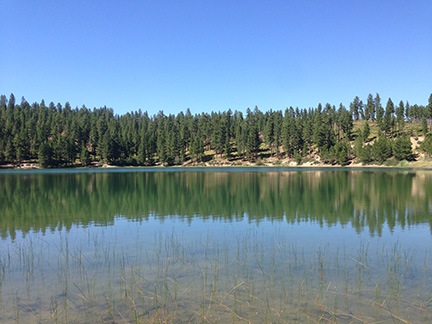
Behive Reservoir isn’t anything special, but it’s a short drive away, up in the mountains south of Wenatchee.
The other day, I briefly explored the area around Beehive Reservoir. I’d driven up there with the goal of checking it out as a possible kayaking destination. The lake I found was small and rather uninteresting. Penny and I walked around its one-mile circumference before continuing up the road. We found a far more interesting web of forest roads that I ached to explore. But without a decent map, I wasn’t comfortable going very far. I decided to return better prepared to explore.
I had a 3-hour window of time on Monday. Penny and I, joined by a friend, climbed into the Jeep and headed out. This time, I had a Wenatchee/Leavenworth trail map with me that clearly identified all the forest roads. We drove up to Beehive Reservoir and kept going.
Our intended destination was Cashmere, on the other side of the mountains. A road numbered 7100 wound through the mountains and a canyon to Cashmere. I’d been on part of the road two years before, picking it up from Number 2 Canyon Road in Wenatchee. It was a relatively easy drive in the Jeep; I figured this would be the same.
But Road 7100 was closed to motor vehicle traffic. They were making improvements somewhere along the way.
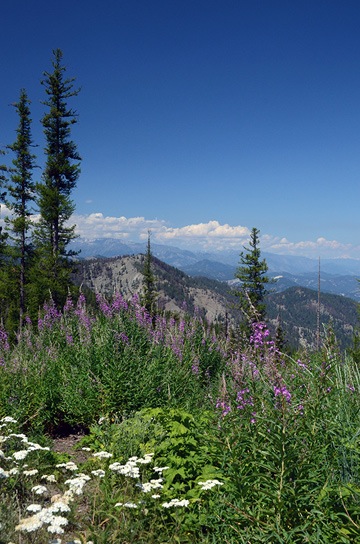
I couldn’t ask for a better day — or better views.
So we followed Road 9712, which went west and then mostly south and east. It climbed pretty steadily into tall pine forest, often skirting the edge of a steep cliff. Every turn offered magnificent views. Although I tried to follow our progress on the map, using turns and trailheads as landmarks, I soon lost track of exactly where we were. That wasn’t a big deal — we could always get back because we didn’t make any turns.
We passed a family of three on mountain bikes: mom, dad, and a girl who couldn’t have been much older than about eight. A strap tied dad’s bike to the kid’s. I guess the logic there was that if the kid went over a cliff, her bike would be saved because it was tied to dad’s. The kid, of course, wasn’t tied to the bike so she’d be lost. Maybe that was the idea. We didn’t see them later on the way back, but their car was still there. Maybe they all went over a cliff. It was not the kind of road suitable for a family outing on bikes. I wonder, sometimes, whether people know how to use their brains.
It was after we made a turn down a steep hill that I got the idea to turn on tracking on my iPhone. I use an app called GPS Track that can keep a breadcrumb trail of where I’ve been. It can also display my position (and track) on a map — if I have a 3G or LTE connection. Since I wasn’t sure whether the road we’d turned down would offer other turns, I turned tracking on. Even if I couldn’t see where we were on a map — which I couldn’t — I’d still be able to follow the track back, even after making a bunch of turns.
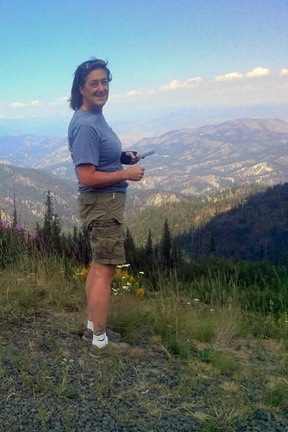
I used my phone to make a panoramic image; my friend used a phone to take a photo of me.
The road we were following descended steadily and then came to an abrupt end in a wide circle with a fire pit in the middle of it. A pickup truck was parked there, but there was no one in sight. We stopped the Jeep and got out to admire the view. We were at about 5,000 feet in elevation and the spot we were on offered a completely unobstructed view of the eastern side of the Cascade Mountains, still blanketed with snow. A variety of wildflowers grew in clumps along the edge of the cliff. It was beautiful and peaceful.
We got out of the Jeep to stretch our legs and take in the view. It was the kind of place that you find it hard to believe exists, a place you know you’re lucky to have stumbled into. I often find places like this when I go exploring in my Jeep. Maybe that’s one of the reasons I like doing it so much.

Not a bad photo for a phone. (Click it to see a larger version.)
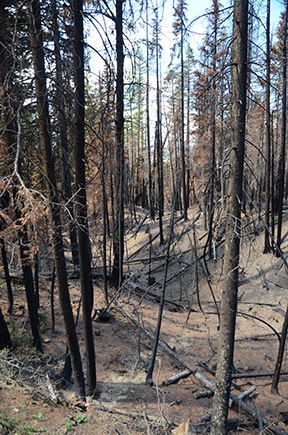
There was lots of evidence of last year’s fires.
We turned around and headed back up to the main road, then turned onto it and continued on our way. The road wound through more forest, up more hills, and over more loose patches of volcanic rock. In some places, the forest was burned out from the previous year’s fires.
The well-maintained road gave way to a narrower, less maintained track. I decided it might be a good idea to figure out where I was. I stopped the Jeep right in the middle of the road — after all, there was no one around — and pulled out my map. I lamented to my friend that I wished I could find a good GPS app for my phone that enabled me to download detailed topo maps so I wouldn’t need a cell signal to use them.
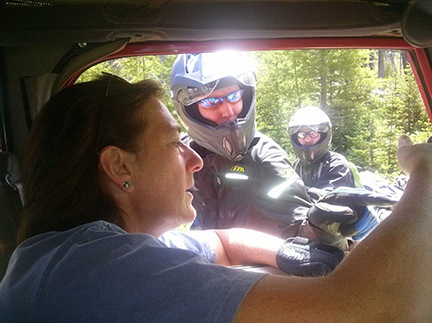
We ran into a pair of motorcyclists who helped us figure out where we were on my map and then recommended a great back road driving app.
I was rather absorbed in my map study when two motorcycles came into view in front of us. The riders were completely geared up and riding good bikes with camping gear fastened to them. I moved to the side to let them pass. They came up beside me and must have noticed I was looking at a map. They stopped and asked if we needed help.
I told them that we weren’t lost but we didn’t know exactly where we were. I know that sounds silly, but in my mind, “lost” means not knowing how to get where you need to go. I didn’t need to go anywhere in front of us and I knew how to get back, so I wasn’t lost. I just didn’t know exactly where I was. Makes sense, no?
One of the guys had a GPS and tried to point out on my map where he thought we were. I told them what I’d been telling my friend: that I wished I had an app that would download maps.
“Gaia GPS,” one of the guys said immediately. “It’s $20 but worth every penny.”
They went on their way. I had a good LTE connection, so I downloaded Gaia GPS on the spot. (I figured that guys outfitted like that had to know what they were talking about.) I used it for the rest of the drive and even saved a track from it for the trip back from our farthest point.
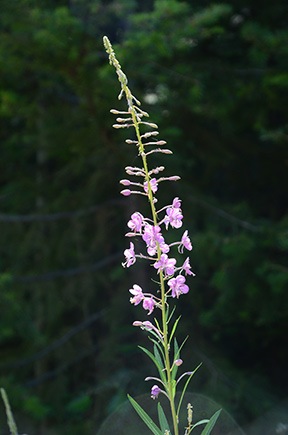
This flower caught my eye as we drove past; I stopped, got out, and took a photo. It’s nice not being rushed by an impatient companion when you’re out for a drive in the forest.
We continued on our way. Soon, however, I was watching the clock. I had a doctor’s appointment at 3:45 and needed to be home by about 3:00 to drop off my friend and make the trip down to Wenatchee. Not sure how long it would take to get back, I set a deadline of about 1:30 to return. It was about 1:00. That gave us just another 30 minutes to explore.
The road continued to wind through the forest, often with sheer cliffs on one side or the other. When we got a good look out to the southeast, I realized that we were on the far side of Mission Ridge, almost at the same altitude. The valley we looked out over was hazy from the smoke of the Colockup Tarps fire, which had started two days before.
I was looking forward to a particularly steep drop-off alongside a section of the road up ahead — that’s what the topo lines showed on the map, anyway — when I realized it was past 1:30. We had to head back. I’d have to make another trip to continue exploring. I marked a waypoint in Gaia GPS so I’d know where I left off and turned around.
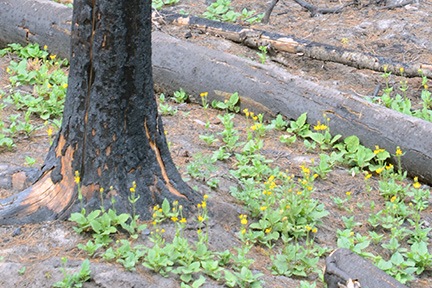
Less than a year after the fire that burned thousands of acres of this forest, flowers were blooming.
The trip back, of course, was much quicker. It always is. We stopped for a nature call and I got some mildly interesting photos of flowers blooming among the burned out trees in the area.
We were back at Beehive Reservoir before we knew it. And back on Squilchuck Road soon after that. In fact, we were back home well before 2:30. We could have stayed out longer after all.
It was a nice trip out — I say that all the time, probably because I enjoy exploring by Jeep so much. I’m looking forward to going out again, perhaps with a hearty picnic lunch, to follow that road to its end.

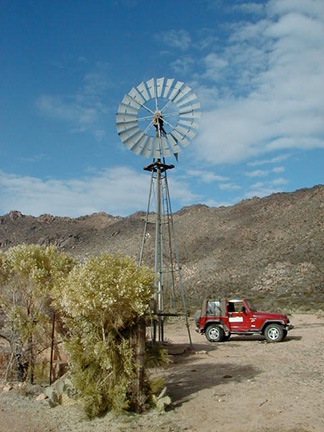
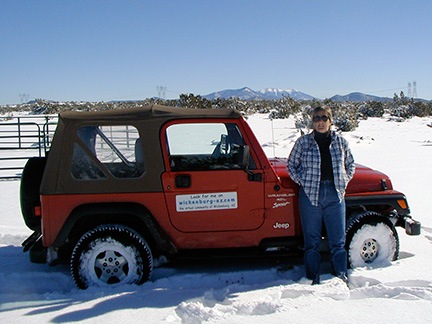

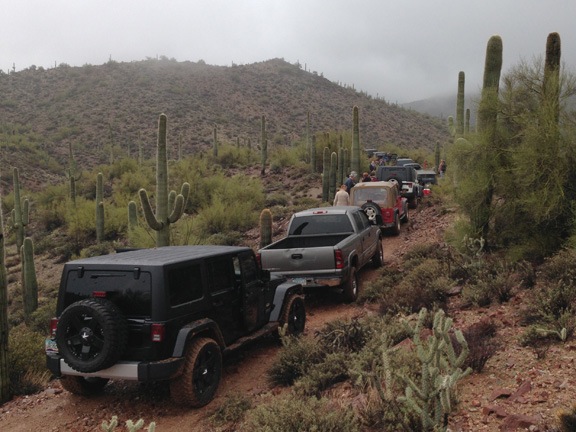
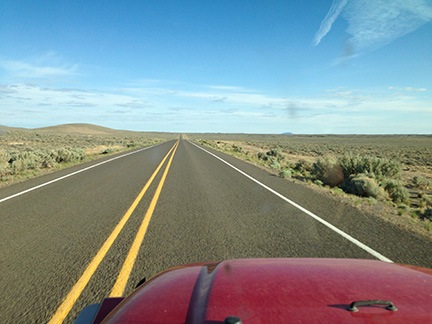
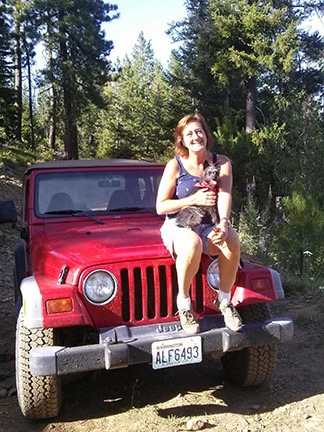
 My Jeep was at Howard Mesa — it had been there for about two months — and I wanted to bring it home. I’d been driving my little Honda S2000 for the whole time it was gone and the poor car was tired of eroded dirt roads and dust. And I was tired of washing it. Besides, as fun as the Honda is to drive, it’s not terribly practical for life in Wickenburg. I’d bought it for road trips and driving down to Phoenix — not for picking up feed for the horses and grocery shopping. And that’s what I’d been doing. (Do you know you can fit three 50-lb bags of horse and chicken feed in the trunk of a Honda S2000?)
My Jeep was at Howard Mesa — it had been there for about two months — and I wanted to bring it home. I’d been driving my little Honda S2000 for the whole time it was gone and the poor car was tired of eroded dirt roads and dust. And I was tired of washing it. Besides, as fun as the Honda is to drive, it’s not terribly practical for life in Wickenburg. I’d bought it for road trips and driving down to Phoenix — not for picking up feed for the horses and grocery shopping. And that’s what I’d been doing. (Do you know you can fit three 50-lb bags of horse and chicken feed in the trunk of a Honda S2000?)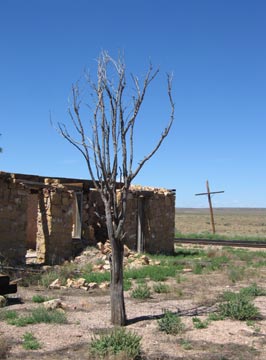 The road crossed the tracks at a place called Willaha. Formerly a train station, the site has the ruins of a building, foundations of at least one other building, and a huge cattle holding pen overgrown with grass and weeds. I could imagine ranchers moving their cattle to this spot, putting them into the pens until the train with cattle cars stopped at the station. Then the cattle would be moved up onto the train and brought to market. Nowadays, the only train that uses the tracks is the Grand Canyon Railway, which runs one or two trains a day on scenic rides between Williams and Grand Canyon. I don’t think any cattle have passed through the corral in years, if not decades.
The road crossed the tracks at a place called Willaha. Formerly a train station, the site has the ruins of a building, foundations of at least one other building, and a huge cattle holding pen overgrown with grass and weeds. I could imagine ranchers moving their cattle to this spot, putting them into the pens until the train with cattle cars stopped at the station. Then the cattle would be moved up onto the train and brought to market. Nowadays, the only train that uses the tracks is the Grand Canyon Railway, which runs one or two trains a day on scenic rides between Williams and Grand Canyon. I don’t think any cattle have passed through the corral in years, if not decades.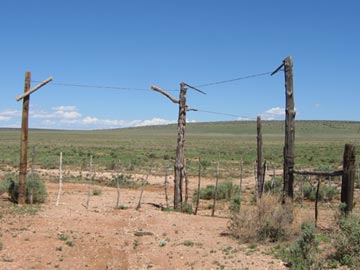 Back at the tracks, I took a left, heading northbound on a two-track road on the west side of the tracks. This road was not on my map, but it was on my GPS. It was easy enough to follow, although it did have quite a few gates to pass through. Most of them were drag gates, like the three-way gate shown here. You may have heard this type of gate referred to as a “cowboy gate” because they’re relatively common out on the range where only the cowboys go.
Back at the tracks, I took a left, heading northbound on a two-track road on the west side of the tracks. This road was not on my map, but it was on my GPS. It was easy enough to follow, although it did have quite a few gates to pass through. Most of them were drag gates, like the three-way gate shown here. You may have heard this type of gate referred to as a “cowboy gate” because they’re relatively common out on the range where only the cowboys go.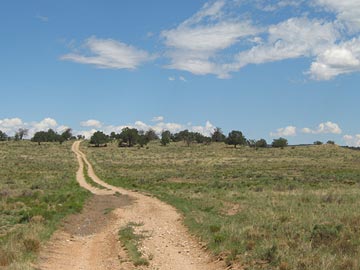 The road followed the tracks north. In most places, it was both smooth and dry. But in some places, water had gathered in the wheel ruts and that water was muddy. I drove through the first spot like that and managed to get mud all over the Jeep as I slid around in the muck. The next muddy spot I reached showed evidence that someone else had driven around it, so I did the same. In other places, the road climbed up a rocky outcropping and got rough with broken rocks, forcing me to slow down. I certainly didn’t want to break a tie rod or something out there.
The road followed the tracks north. In most places, it was both smooth and dry. But in some places, water had gathered in the wheel ruts and that water was muddy. I drove through the first spot like that and managed to get mud all over the Jeep as I slid around in the muck. The next muddy spot I reached showed evidence that someone else had driven around it, so I did the same. In other places, the road climbed up a rocky outcropping and got rough with broken rocks, forcing me to slow down. I certainly didn’t want to break a tie rod or something out there.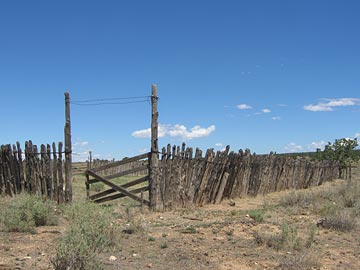 We reached Anita Station, where several roads intersected at the remnants of another cattle pen. Jack and I got out and walked around a bit. I saw the remains of several other buildings, reduced to mere concrete slabs. It was already close to 11 AM and I expected the train soon. But I couldn’t hear it coming, nor see its black smoke on the horizon. I decided to continue up the two-track road.
We reached Anita Station, where several roads intersected at the remnants of another cattle pen. Jack and I got out and walked around a bit. I saw the remains of several other buildings, reduced to mere concrete slabs. It was already close to 11 AM and I expected the train soon. But I couldn’t hear it coming, nor see its black smoke on the horizon. I decided to continue up the two-track road.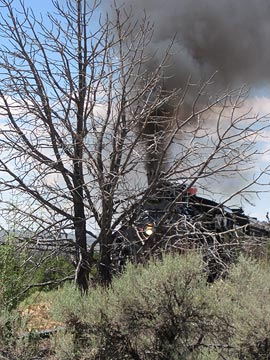 I heard the train coming and returned to my photo spot. As the train came puffing into view, I realized I’d picked a terrible spot for photos. I was too close to the tracks and there were too many trees in the way. For some reason, I’d imagined the train being bigger. It wasn’t. I offer this photo as an example of a good plan gone bad. I laughed at myself as the train passed and I walked back to the Jeep.
I heard the train coming and returned to my photo spot. As the train came puffing into view, I realized I’d picked a terrible spot for photos. I was too close to the tracks and there were too many trees in the way. For some reason, I’d imagined the train being bigger. It wasn’t. I offer this photo as an example of a good plan gone bad. I laughed at myself as the train passed and I walked back to the Jeep.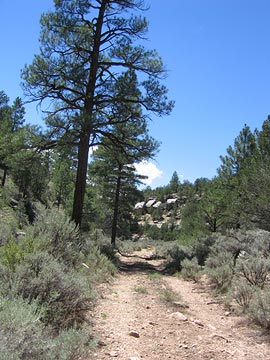 The canyon and road ended at an intersection: FR 2615 again. I wanted to go north, to the other side of the tracks. So I turned left. I realized about two miles down the road that left was wrong — it would just bring me back to the mud puddle — and backtracked yet again. I headed northeast on FR 2615, following it up Rain Tank Wash. The open meadow-like area closed up to another canyon and I followed the road through it. Although my map showed that the road ended not far after I’d gotten on it, I had become accustomed to roads continuing beyond their map ends. This one continued for a good two miles up the wash while steep walls and pine trees closed around us.
The canyon and road ended at an intersection: FR 2615 again. I wanted to go north, to the other side of the tracks. So I turned left. I realized about two miles down the road that left was wrong — it would just bring me back to the mud puddle — and backtracked yet again. I headed northeast on FR 2615, following it up Rain Tank Wash. The open meadow-like area closed up to another canyon and I followed the road through it. Although my map showed that the road ended not far after I’d gotten on it, I had become accustomed to roads continuing beyond their map ends. This one continued for a good two miles up the wash while steep walls and pine trees closed around us.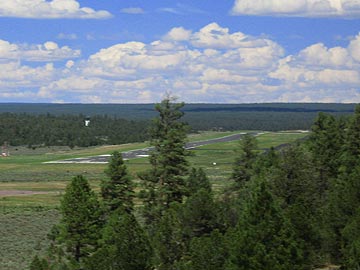 The road reached a clearing where the earth dropped away in front of us. There, in the near distance, was the approach end of Runway 3 at Grand Canyon Airport.
The road reached a clearing where the earth dropped away in front of us. There, in the near distance, was the approach end of Runway 3 at Grand Canyon Airport.